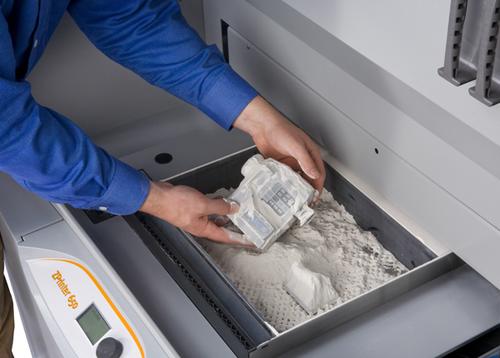
Political power grows out of the nozzle of a 3-D Printer.
Posted on 08/08/2013 1:03:48 PM PDT by null and void
A 3D printer generally moves its printing mechanism in straight paths on it’s x, y and z axes. But a new printer developed by Brian Harms, a masters student at the Southern California Institute of Architecture in Los Angeles, uses a robotic arm to print in a freeform manner, angling this way and that, poking its extruder in and out of a bed of gel, where it injects its light-curing resin. By depositing the print material in the gelatinous medium, there is no need for any support structures — the resin stays suspended at its precise x,y,z point. When the print is done, you pull it out of the reusable gel and wipe the gel away.
The new process he calls “Suspended Depositions” is differentiated from other 3D printing processes because it uses 3D vector-based toolpaths rather than paths generated via contouring a digital model.

Political power grows out of the nozzle of a 3-D Printer.
Bump
How does 3d printing work? Does it print stuff made out of paper? Or will it print metal objects?
It works by building up layers of material, each layer looks like what you’d get if you sliced the object at that level, or did a CAT scan.
Yes, one printer makes the layers out of paper, but the most common material is plastic extruded out of what amounts to a hot-melt glue gun. Pretty much anything that melts and refreezes at a reasonable temperature will do, up to and including chocolate!
Another technique is to expose a liquid polymer to a patterned or scanned UV light that hardens the liquid into a solid.
Still another selectively fuses layers of powder. One technique uses an inkjet printer head to squirt droplets of glue and/or ink onto the powder, another uses a scanned laser to melt select areas together. Materials include plastics, plaster, glass (sand), sugar, and a wide variety of metals, from copper through stainless steels, to exotic titanium alloys.
And lastly, a few companies build up the parts with repeated welding beads.
Interesting stuff. And scary. Apparently there’s nothing that can’t be done.
I remember back in the early 90s someone told me “One day you’ll be able to send and receive faxes from your car.” He was almost right. He missed the part about email being invented. And speaking of email, the first time I heard that word was Ross Perot talking about it on Larry King Live. It sounded very weird.
Around that same time I told my wife that one day there would be a box on top of the TV where you could slide a card and buy things from stores and the items would be delivered. All I missed were the boxes.
Email goes back a long way, invented by Ray Tomlinson in 1971 (first internet-based email). 3-D printers, although gone mainstream recently in their current configurations, have been around a while also based on 2-D printers (1984). They're about where PC's were in the late 1970's. Going to be a big deal in a few years, particularly in building human body parts.
Commodore PET CIRCA '77 versus today's high end multicore, over-clocked gamming PC's of today - Yeah Ha! Let the physical innovations begin!
I can foresee nano deposition, mult-material printers coming into production within 5 to 10 years - able to produce a broad range of objects based on a combination of plastics, ceramics, metals (materials available now), culminating with bio-materials...
This will an amazing ride of creativity!
Disclaimer: Opinions posted on Free Republic are those of the individual posters and do not necessarily represent the opinion of Free Republic or its management. All materials posted herein are protected by copyright law and the exemption for fair use of copyrighted works.